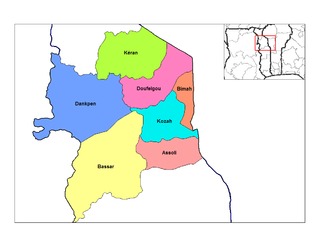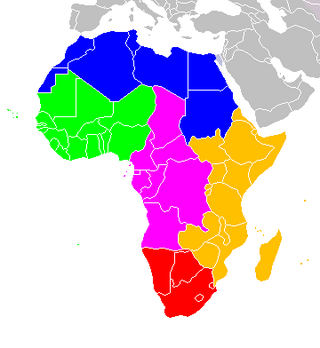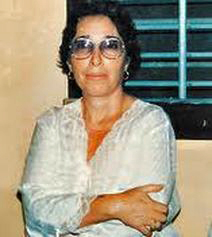
The Togolese Armed Forces is the national military of the Republic of Togo which consists of the Army, Navy, Air Force, and the National Gendarmerie. The total military expenditure during the fiscal year of 2005 was 1.6% of the country's GDP. Military bases exist in Lomé, Temedja, Kara, Niamtougou, and Dapaong. The current Chief of the General Staff is Brigadier General Dadja Maganawe, who took office on December 6, 2020.

This article deals with the diplomatic affairs, foreign policy and international relations of Uruguay. At the political level, these matters are officially handled by the Ministry of Foreign Relations, also known as Cancillería, which answers to the President.

Vodun is a religion practiced by the Aja, Ewe, and Fon peoples of Benin, Togo, Ghana, and Nigeria.

Gnassingbé Eyadéma was a Togolese military officer and politician who was the president of Togo from 1967 until his death in 2005, after which he was immediately succeeded by his son, Faure Gnassingbé.

Kpalimé is a city in the Plateaux Region of Togo, 120 km north of Lomé and 15 km from the border with Ghana. It is the administrative capital of Kloto Prefecture. Kpalimé has a population of 75,084, making it the fourth-biggest town in Togo, after Lomé, Sokodé and Kara. The town has a cathedral, a scientific lycée, and a post-office, as well as several banks, medical centres, pharmacies, cyber-cafés and petrol stations.

Faure Essozimna Gnassingbé Eyadéma is a Togolese politician who has been the president of Togo since 2005. Before assuming the presidency, he was appointed by his father, President Gnassingbé Eyadéma, as Minister of Equipment, Mines, Posts, and Telecommunications, serving from 2003 to 2005.

The Oti River or Pendjari River is an international river in West Africa. It rises in Benin, forms the border between Benin and Burkina Faso, flows through Togo, and joins the Volta River in Ghana.

The Guinean forest-savanna mosaic, also known as the Guinean forest-savanna transition, is a distinctive ecological region located in West Africa. It stretches across several countries including Guinea, Sierra Leone, Liberia, Ivory Coast, Ghana, Togo, Benin, Nigeria, and Cameroon. This region is characterized by a unique blend of forested areas and savannas, creating a diverse and dynamic landscape.
Kabiye is an Eastern Gurunsi Gur language spoken primarily in northern Togo. Throughout the 20th century, there was extensive migration to the centre and south of Togo and also to Ghana and Benin. Kabiye speakers made up over 23% of the Togolese population in 1999.
"Kawa no nagare no yō ni" is the last single recorded by Japanese enka singer Hibari Misora, as she died soon after its release in 1989. It was composed by Akira Mitake, with lyrics by Yasushi Akimoto. The single charted at 8th place for more than a year and sold 225,000 copies in Japan. It was voted the greatest Japanese song of all time during a national poll in 1997 by NHK, with more than 10 million votes. It is often the song of choice for artists performing live tributes to Misora. It is also covered by various singers, including Teresa Teng, The Three Tenors and Mariachi Vargas de Tecalitlán.

Dankpen is a prefecture located in the Kara Region of Togo. The prefecture covers 2 690 km², with a population in 2010 of 130 723. The prefecture seat is located in Guérin-Kouka. It is split into 12 cantons, Guérin-Kouka, Bapuré, Nandouta, Kidjaboum, Namon, Nawaré, Katchamba, Nampoch, Natchiboré, Natchitikpi, Koulfièkou, and Koutchichéou.

Ábrego is a Colombian municipality and town located in the department of Norte de Santander. The urban centre is situated at an altitude of 1,398 metres (4,587 ft) in the Eastern Ranges of the Colombian Andes.

Portuguese Africans are Portuguese people born or permanently settled in Africa. The largest Portuguese African population lives in Portugal numbering over 1 million with large and important minorities living in South Africa, Namibia and the Portuguese-speaking African countries .The descendants of the Portuguese settlers who were born and "raised" locally since Portuguese colonial time were called crioulos. Much of the original population is unnumbered having been assimilated into Portugal, Brazil, and other countries.
Kawa, Togo is a village in the Bimah Prefecture in the Kara Region of north-eastern Togo.

Cristián Patricio Larroulet Vignau was the Minister General Secretariat of the Presidency of Chile under President Sebastián Piñera. He currently serves as the Head of Advisors to the Presidency of the Republic in the second administration of Sebastián Piñera.

Blanca Jeannette Kawas Fernández was a Honduran environmental activist known for her role in saving more than 400 species of flora and fauna.
Mass media in Togo includes radio, television, and online and print formats. The Agence Togolaise de Presse news agency began in 1975. The Union des Journalistes Independants du Togo press association is headquartered in Lomé.
Ana Mariella Bacigalupo is a Peruvian anthropologist. She is a full professor at the State University of New York at Buffalo and has previously taught throughout the USA and in Chile. Her research primarily focuses on the shamans or machis of the Mapuche community of Chile, and the ways shamanic practices and beliefs are affected by and influence communal experiences of state power, mythical history, ethics, gender, justice, and identity.
Qnât, Qnat, Qanat, Knat or Kanat is a municipality in the Bsharri District of Lebanon. The village is located just south of a large cliff and near the towns of Mazraat Bani Saab and Hadath El Jebbeh. The town is a member of the Federation of Municipalities of Bcharreh District. The name of the town comes from the Semitic root word "Qna" meaning ′Good Livelihood", the name was also attributed to the God El, whose Daughter was called the goddess Anat in Greek mythology, (. ............ Greek Mythology: As for what was stated in a book by Father Boutros Daou, that the name "Anat" is the same as the name of the Heroic Deity "Anat" the Phoenician daughter of the greatest god "El" who was mentioned many times in Ras Shamra "ugarit" tables, also in epics and songs of king Melqart]], and the hymn of Aqhat Bin Daniel "Attributes of the Gods Anat, the warrior virgin the goddess of Wisdom, Two queens on two of its hills, each queen facing the other queen, the remains of the palaces are still existing our days at Qnat..... Anat was one of the main goddesses in the pantheon of Ugarit,[44][45] a city located in the north of modern Syria on the Mediterranean coast whose religion was closely related to that of Mari.[46] According to the Ugaritic texts, Anat resides on a mountain known under the name ‘Inbubu", whose location remains unknown. Activities: Qnat also has a sports club named CRS QNAT, founded in 1954. main sports are Volleyball and Table Tennis, The club, headed was originally headed by Mr. Mounir Chahine, and later by Mr. Emile Jabbour, and currently by Joseph Mounir Chahine, the Club team has won Lebanon's championship multiple times, including in 2020.













